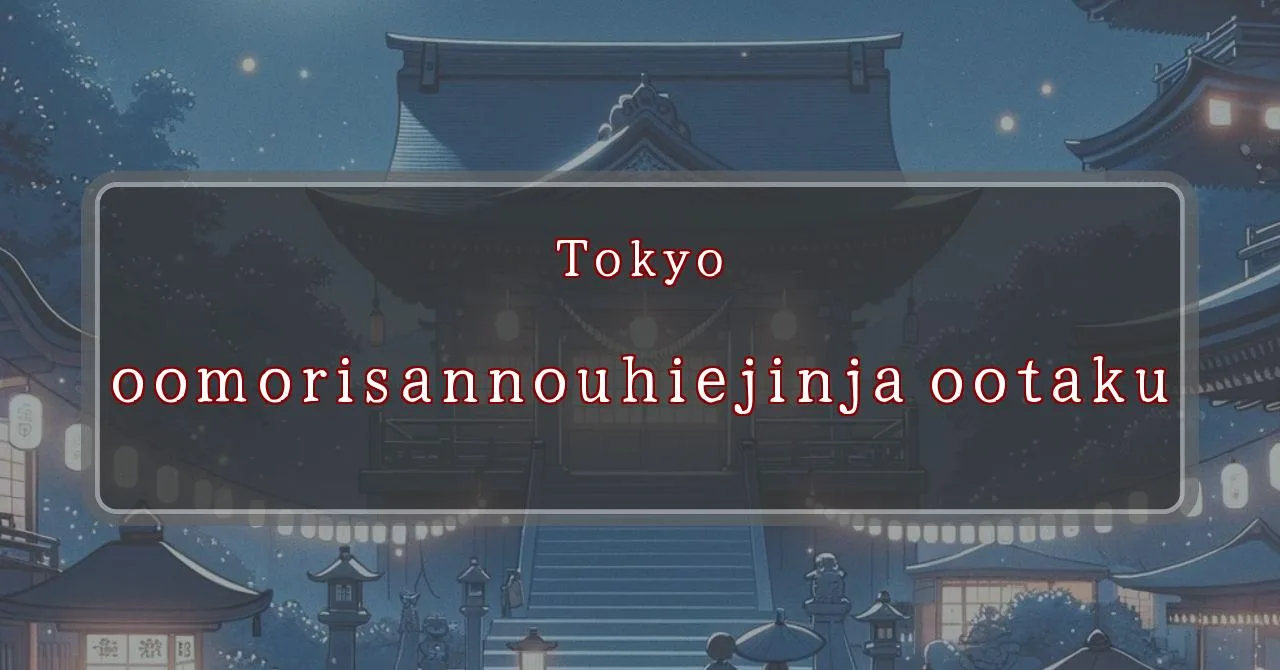Oomori Sannou Hie Shrine: A sacred oasis amidst the urban landscape
Basic Information
Oomori Sannou Hie Shrine is a Shinto shrine located in Ota Ward, Tokyo, Japan. It is dedicated to the deities Ooyamakuinomikoto and Ookuninushi no Mikoto, who are associated with agriculture, commerce, and good fortune.
- Address: 1-6-2 Sannou, Ota-ku, Tokyo 143-0023
- Phone Number: 03-3771-1916
- Access: A 2-minute walk from the north exit of JR Keihin Tohoku Line Omori Station
- Festival Days: Third Saturday and Sunday of September
Main Events and Attractions of the Festival
The Oomori Sannou Hie Shrine Festival is a lively and colorful event that attracts many visitors each year. The main events and attractions of the festival include:
Mikoshi Procession
The highlight of the festival is the mikoshi procession, which takes place on the third Saturday of September. A mikoshi is a portable shrine that is carried through the streets by a team of people. The mikoshi of Oomori Sannou Hie Shrine is particularly large and impressive, and it is carried by a team of over 100 people.
Lion Dance
Another popular attraction of the festival is the lion dance. The lion dance is performed by a team of dancers who wear colorful lion costumes. The dancers perform a variety of acrobatic feats, including jumping, tumbling, and balancing on poles.
Yatai Village
During the festival, a yatai village is set up in the grounds of the shrine. Yatai are small stalls that sell food and drinks. The yatai village at Oomori Sannou Hie Shrine offers a wide variety of food and drinks, including yakisoba, takoyaki, and kakigori.
Benefits and Deities
Oomori Sannou Hie Shrine is dedicated to the deities Ooyamakuinomikoto and Ookuninushi no Mikoto. Ooyamakuinomikoto is the god of agriculture, while Ookuninushi no Mikoto is the god of commerce and good fortune. Visitors to the shrine pray for good harvests, financial success, and good luck in business.
History and Legends
The origins of Oomori Sannou Hie Shrine are unclear, but it is believed to have been founded in the Kamakura period (1185-1333). The shrine was originally located in a different part of Ota Ward, but it was moved to its current location in 1677. The shrine was destroyed by fire in 1945, but it was rebuilt in 1960.
Tips and注意事項 for Visitors
If you are planning to visit the Oomori Sannou Hie Shrine Festival, here are a few tips and注意事項:
- The festival is very crowded, so it is important to wear comfortable shoes.
- There are no parking facilities at the shrine, so it is best to use public transportation.
- The festival is held outdoors, so it is important to dress appropriately for the weather.
- There are a number of food and drink stalls at the festival, but it is also a good idea to bring your own food and drinks.
Blessings and Deities
Oomori Sannouushi no Mikoto. Ooyamakuinomikoto is the god of agriculture, while Ookuninushi no Mikoto is the god of commerce and good fortune. Visitors to the shrine pray for good harvests, financial success, and good luck in business.
Origin and History
The origins of Oomori Sannou Hie Shrine are unclear, but it is believed to have been founded in the Kamakura period (1185-1333). The shrine was originally located in a different part of Ota Ward, but it was moved to its current location in 1677. The shrine was destroyed by fire in 1945, but it was rebuilt in 1960.
Tips and Notes for Visitors
If you are planning to visit the Oomori Sannou Hie Shrine Festival, here are a few tips and注意事項:
- The festival is very crowded, so it is important to wear comfortable shoes.
- There are no parking facilities at the shrine, so it is best to use public transportation.
- The festival is held outdoors, so it is important to dress appropriately for the weather.
- There are a number of food and drink stalls at the festival, but it is also a good idea to bring your own food and drinks.
Parking Information
There are no parking facilities at Oomori Sannou Hie Shrine. Visitors are advised to use public transportation.
Popular Stalls and Food Carts in Recent Years
| Type of Stall | Description |
|---|---|
| Takoyaki | A staple at Japanese festivals. Characterized by a crispy outside and a creamy inside. |
| Jaga Butter | A simple yet popular snack of hot potatoes lavishly topped with melted butter. |
| Baby Castella | Small castella cakes, sweet and fluffy treats enjoyed by children and adults alike. |
| Grilled Ayu with Salt | Fresh ayu fish grilled whole with salt, a savory taste of Japanese summer. |
| Shaapin | A unique gourmet item influenced by foreign cuisine, with a chewy skin wrapping the filling. |
| Okonomiyaki | A Japanese grilled dish where you often choose your own ingredients for a personalized flavor. |
| Cotton Candy | A fluffy, sweet snack that’s extremely popular with children. |
| Chocolate Banana | A banana coated in chocolate, a fun and visually appealing dessert. |
| Kushiyaki | Various types of ingredients skewered and grilled, an easy-to-enjoy snack. |
| Yakisoba | Fried noodles mixed with a special sauce, a fast food favorite in Japan. |



